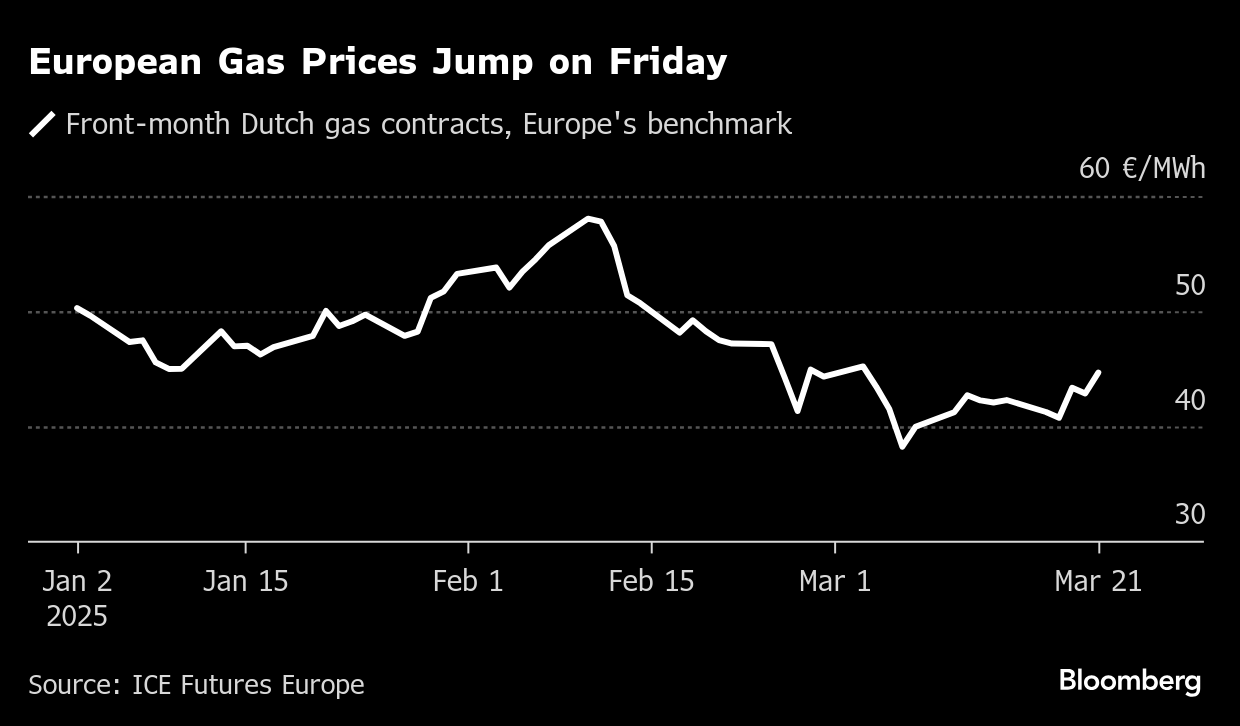European Gas Jumps After Attack on Russia-Ukraine Transit Point
Mar 21, 2025 by Bloomberg(Bloomberg) -- European natural gas prices jumped after an attack on a pumping station in Russia’s Kursk region, which formed part of an inactive link that sent fuel to the continent until recently.
Benchmark futures rose as much as 6.2% in early trading on Friday before easing gains. Ukraine’s General Staff of the Armed Forces confirmed the Sudzha gas metering station was shelled, but said it was Russians who struck the facility, pointing to previous instances in which Russia appeared to send soldiers through a disused natural gas pipeline.
Russia’s Defense Ministry said Kyiv deliberately blew up the station, which was under the control of Ukrainian Armed Forces since last August before the area was reclaimed by Russian forces this month.
Serious damage could make the resumption of Russian gas supplies more unlikely, a prospect that was already in retreat after a 30-day ceasefire didn’t immediately emerge as a first step toward a peace deal. Russia and Ukraine’s leaders indicated they’d agree to a ceasefire on attacking energy infrastructure, but so far that has not led to a halt in attacks.

The transit point is part of a pipeline link that — up until the start of this year — brought Russian gas to Europe. Some countries that previously depended on those flows had hoped they would eventually resume. NASA satellite imagery indicated wide-scale fires covered the gas-station area and the surrounding territory.
“Those in the gas market that hope Russian exports may resume along this transit line when the war ends will now be looking to gauge the extent of the damage to the infrastructure and crucially how quickly it could be repaired by Gazprom,” said Tom Marzec-Manser, an independent gas analyst.
Gazprom PJSC, which previously controlled the transit point, did not immediately respond to a request for comment. Ukraine’s gas transmission operator declined to comment on the incident that occurred on Russian territory.
Price gains eased in the course of the morning as traders digested the limited short-term impact from the blast. In addition to the link not being used currently, damage could be repaired if there were a political decision to resume flows.
“A fix could range from weeks to a year or two, depending upon the availability of replacements and the severity of the damage,” said Ronald Smith from Emerging Markets Oil & Gas Consulting Partners LLC. “The major issue here remains one of finding a political resolution to the conflict and restarting full economic relations between Europe and Russia, not so much in the infrastructure.”
In addition, there could be multiple routes for Russia to send gas to Europe. The country used several cross-border points in the past, but their number fell to two by 2022 after Moscow launched its full-scale invasion. In May that year, supplies via the Sokhranivka point stopped after Ukraine said it can’t control the facility because of occupied forces.

Flows of Russian fuel through Ukraine ended at the start of this year when a transit agreement expired, and expensive liquefied natural gas cargoes leave Europe exposed to competition with other buyers. The continent faces a challenging stockpiling season after stronger-than-usual withdrawals this winter have left gas reserves at their lowest levels since 2022.
Dutch front-month futures, Europe’s gas benchmark, were higher at € a megawatt-hour by 12:07 p.m. in Amsterdam.
Friday’s market reaction suggests “at least a partial resumption of flows had been factored by the market,” said Bloomberg Intelligence senior analyst Patricio Alvarez. “Absent any geopolitical-driven supply shifts, European gas markets are poised to tighten this summer as the region works to plug a wider storage reinjection gap.”
©2025 Bloomberg L.P.
By


















